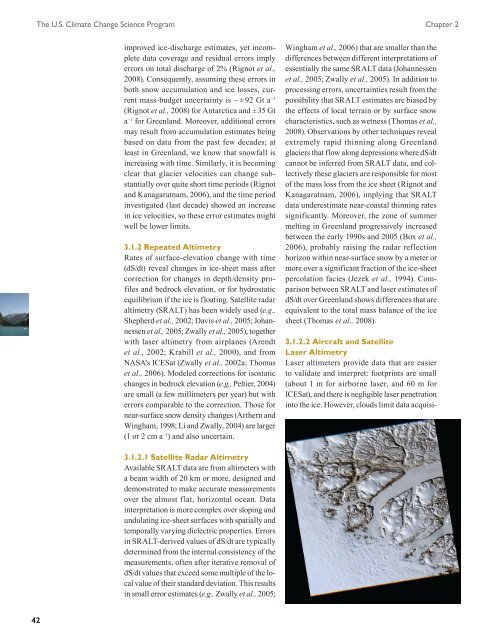Book 2.indb - US Climate Change Science Program
Book 2.indb - US Climate Change Science Program
Book 2.indb - US Climate Change Science Program
- No tags were found...
You also want an ePaper? Increase the reach of your titles
YUMPU automatically turns print PDFs into web optimized ePapers that Google loves.
The U.S. <strong>Climate</strong> <strong>Change</strong> <strong>Science</strong> <strong>Program</strong> Chapter 2improved ice-discharge estimates, yet incompletedata coverage and residual errors implyerrors on total discharge of 2% (Rignot et al.,2008). Consequently, assuming these errors inboth snow accumulation and ice losses, currentmass-budget uncertainty is ~ ± 92 Gt a –1(Rignot et al., 2008) for Antarctica and ± 35 Gta –1 for Greenland. Moreover, additional errorsmay result from accumulation estimates beingbased on data from the past few decades; atleast in Greenland, we know that snowfall isincreasing with time. Similarly, it is becomingclear that glacier velocities can change substantiallyover quite short time periods (Rignotand Kanagaratnam, 2006), and the time periodinvestigated (last decade) showed an increasein ice velocities, so these error estimates mightwell be lower limits.3.1.2 Repeated AltimetryRates of surface-elevation change with time(dS/dt) reveal changes in ice-sheet mass aftercorrection for changes in depth/density profilesand bedrock elevation, or for hydrostaticequilibrium if the ice is floating. Satellite radaraltimetry (SRALT) has been widely used (e.g.,Shepherd et al., 2002; Davis et al., 2005; Johannessenet al., 2005; Zwally et al., 2005), togetherwith laser altimetry from airplanes (Arendtet al., 2002; Krabill et al., 2000), and fromNASA’s ICESat (Zwally et al., 2002a; Thomaset al., 2006). Modeled corrections for isostaticchanges in bedrock elevation (e.g., Peltier, 2004)are small (a few millimeters per year) but witherrors comparable to the correction. Those fornear-surface snow density changes (Arthern andWingham, 1998; Li and Zwally, 2004) are larger(1 or 2 cm a –1 ) and also uncertain.Wingham et al., 2006) that are smaller than thedifferences between different interpretations ofessentially the same SRALT data (Johannessenet al., 2005; Zwally et al., 2005). In addition toprocessing errors, uncertainties result from thepossibility that SRALT estimates are biased bythe effects of local terrain or by surface snowcharacteristics, such as wetness (Thomas et al.,2008). Observations by other techniques revealextremely rapid thinning along Greenlandglaciers that flow along depressions where dS/dtcannot be inferred from SRALT data, and collectivelythese glaciers are responsible for mostof the mass loss from the ice sheet (Rignot andKanagaratnam, 2006), implying that SRALTdata underestimate near-coastal thinning ratessignificantly. Moreover, the zone of summermelting in Greenland progressively increasedbetween the early 1990s and 2005 (Box et al.,2006), probably raising the radar reflectionhorizon within near-surface snow by a meter ormore over a significant fraction of the ice-sheetpercolation facies (Jezek et al., 1994). Comparisonbetween SRALT and laser estimates ofdS/dt over Greenland shows differences that areequivalent to the total mass balance of the icesheet (Thomas et al., 2008).3.1.2.2 Aircraft and SatelliteLaser AltimetryLaser altimeters provide data that are easierto validate and interpret: footprints are small(about 1 m for airborne laser, and 60 m forICESat), and there is negligible laser penetrationinto the ice. However, clouds limit data acquisi-3.1.2.1 Satellite Radar AltimetryAvailable SRALT data are from altimeters witha beam width of 20 km or more, designed anddemonstrated to make accurate measurementsover the almost flat, horizontal ocean. Datainterpretation is more complex over sloping andundulating ice-sheet surfaces with spatially andtemporally varying dielectric properties. Errorsin SRALT-derived values of dS/dt are typicallydetermined from the internal consistency of themeasurements, often after iterative removal ofdS/dt values that exceed some multiple of the localvalue of their standard deviation. This resultsin small error estimates (e.g., Zwally et al., 2005;42






